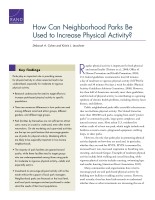| 来源类型 | Research Reports
|
| 规范类型 | 报告
|
| DOI | https://doi.org/10.7249/RR2490
|
| 来源ID | RR-2490-NHLBI
|
| How Can Neighborhood Parks Be Used to Increase Physical Activity? |
| Deborah A. Cohen; Kristin J. Leuschner
|
| 发表日期 | 2018
|
| 出版年 | 2018
|
| 页码 | 12
|
| 语种 | 英语
|
| 结论 |
Although parks play an important role in providing venues for physical activity in urban areas, they tend to be underutilized, especially for moderate to vigorous physical activity.- Research underscores the need to target efforts to increase park-based physical activity to specific populations.
- There are numerous differences in how parks are used among different racial and ethnic groups, different genders, and different age groups.
- Park facilities by themselves are not sufficient to attract users; many sit unused or underused, even after recent renovations. On-site marketing and supervised activities are the top two park features that encourage greater use of parks for physical activity. Marketing efforts are likely to be especially important in low-income neighborhoods.
- The majority of park facilities are geared toward youths, while fewer facilities tend to target groups who are underrepresented among those using parks for moderate to vigorous physical activity — adults and especially seniors.
- Investments to encourage physical activity will not be made without the support of local park managers. Neighborhood parks are financed on the local level, and local park managers are best positioned to understand the needs of their local populations.
|
| 摘要 |
- Target efforts to increase park-based physical activity to specific populations. One option for increasing park use among some underserved populations might be to offer group exercise activities that promote both exercise and social interaction.
- Offer more supervised activities and engage in marketing efforts to reach potential users. Marketing efforts are likely to be especially important in low-income neighborhoods, where parks might not be meeting the needs of local residents.
- Carefully target investments in new facilities to increase park use for physical activities. Such features as walking loops might be the most-beneficial investments for adult and senior users. Another promising option would be to increase the number of parks so that most people would reside within a half-mile journey or ten-minute walk to a park as a common national standard.
- Park managers, who are best positioned to understand the needs of their local populations, should define benchmarks for optimal use of local parks. Managers can begin by identifying how many people are currently using the parks for moderate to vigorous physical activity, which groups are underrepresented among park users, how much physical activity the parks can support, and how the parks can best attract that level of users on a routine basis.
|
| 主题 | Community Health
; Neighborhood Influences on Health
; Physical Exercise
; Urban Parks and Recreational Facilities
|
| URL | https://www.rand.org/pubs/research_reports/RR2490.html
|
| 来源智库 | RAND Corporation (United States)
|
| 引用统计 |
|
| 资源类型 | 智库出版物
|
| 条目标识符 | http://119.78.100.153/handle/2XGU8XDN/108880
|
推荐引用方式
GB/T 7714 |
Deborah A. Cohen,Kristin J. Leuschner. How Can Neighborhood Parks Be Used to Increase Physical Activity?. 2018.
|
|
文件名:
|
x1540239637188.jpg
|
|
格式:
|
JPEG
|

|
文件名:
|
RAND_RR2490.pdf
|
|
格式:
|
Adobe PDF
|
除非特别说明,本系统中所有内容都受版权保护,并保留所有权利。